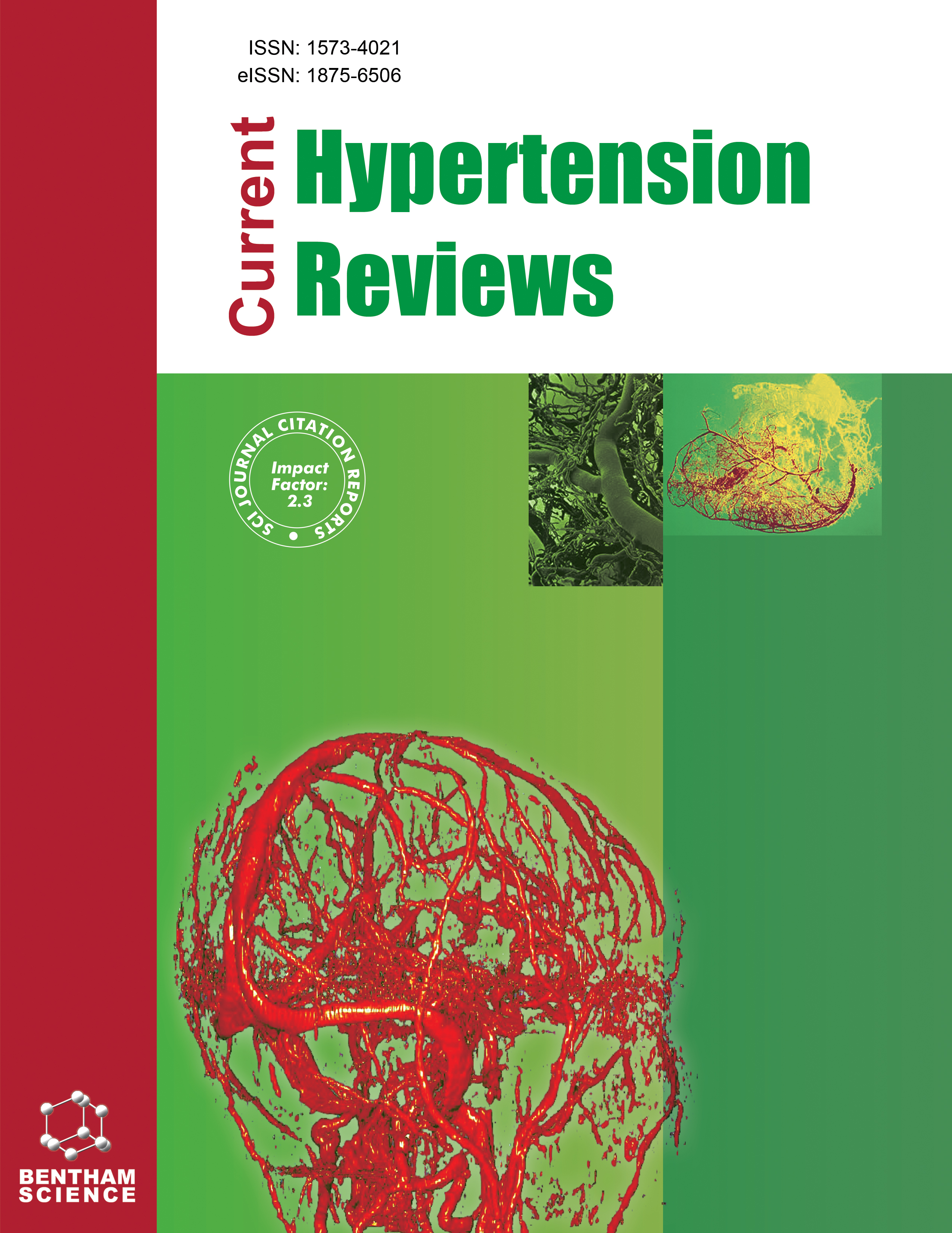- Home
- A-Z Publications
- Current Hypertension Reviews
- Previous Issues
- Volume 7, Issue 4, 2011
Current Hypertension Reviews - Volume 7, Issue 4, 2011
Volume 7, Issue 4, 2011
-
-
Editorial [Hot Topic: Adrenomedullin in Hypertension and Beyond (Guest Editor: Johji Kato)]
More LessBy Johji KatoNumerous humoral factors have been shown to be involved in regulating blood pressure and electrolyte-fluid balance in mammals, such as catecholamines, angiotensin peptides, aldosterone, natriuretic peptides, and endothelins. In 1993, a biologically active peptide discovered in human pheochromocytoma tissue by Kitamura and coworkers was added to the list. This peptide was termed adrenomedullin (AM) because it w Read More
-
-
-
Molecular Basis of Adrenomedullin 1 Receptor Function and Its Roles in the Cardiovascular System
More LessAuthors: Kenji Kuwasako, Kazuo Kitamura, Sayaka Nagata and Johji KatoAdrenomedullin (AM), a hypotensive peptide, exerts powerful anti-oxidative, anti-inflammatory and antiatherosclerotic effects. In addition, AM strongly acts as an angiogenic and lymphangiogenic growth factor. Therefore, AM has attracted a great deal of attention as a potential therapeutic agent against cardiovascular diseases, such as acute myocardial infarction, heart failure, arteriosclerosis obliterans, pulmonary hyperte Read More
-
-
-
Adrenomedullin-RAMP2 System in Cardiovascular Development and Homeostasis
More LessAuthors: Takayuki Shindo, Takayuki Sakurai, Akiko Kamiyoshi and Yuka Ichikawa-ShindoAdrenomedullin (AM), originally identified as a vasodilating peptide, is now recognized to be a pleiotropic vasoactive molecule involved in both the pathogenesis of cardiovascular diseases and circulatory homeostasis. To elucidate the in vivo roles of AM, we have established and analyzed genetically engineered AM mice and its receptor components. Heterozygotes of AM knockout mice (AM+/-) showed blood pressure elev Read More
-
-
-
Adrenomedullin Function in Vascular Endothelial Cells: Insights from Genetic Mouse Models
More LessAdrenomedullin is a highly conserved peptide implicated in a variety of physiological processes ranging from pregnancy and embryonic development to tumor progression. This review highlights past and present studies that have contributed to our current appreciation of the important roles adrenomedullin plays in both normal and disease conditions. We provide a particular emphasis on the functions of adren Read More
-
-
-
Neuroprotection and Behavior Regulation by Adrenomedullin and PAMP as Shown by Conditional Knockout Models
More LessThe adrenomedullin (AM) gene, adm, is widely expressed in the central nervous system and several functions have been suggested for brain AM. Until recently, a formal confirmation of these actions using genetic models has been elusive since the systemic adm knockout results in embryo lethality. The recent development of Cre/loxP conditional knockouts for this gene has opened a door for detailed physiopathological studi Read More
-
-
-
Adrenomedullin and Oxidative Stress in Vascular Damage and Metabolic Disease
More LessWe have studied the pleiotropic effects of adrenomedullin with knockout mice and found that it is a potent intrinsic antioxidant. Oxidative stress is related to cardiovascular as well as metabolic diseases. In this review, the coronary, pulmonary, and cerebrovascular damage that was observed in adrenomedullin-knockout mice is reviewed. An angiotensin II-loaded model, a hypoxia model, and a vascular occlusion model were appli Read More
-
-
-
Adrenomedullin in Hypertension and Obesity
More LessAuthors: Johji Kato, Kenji Kuwasako and Kazuo KitamuraAdrenomedullin (AM), a biologically active peptide first detected in human pheochromocytoma, has been shown to be present in various tissues or organs, such as blood vessels, cardiac muscle, kidneys, and adipose tissue. AM exerts a wide range of actions, including those lessening cardiovascular damage associated with hypertension or obesityrelated disorders. This bioactive peptide was found to circulate in the hu Read More
-
-
-
Adrenomedullin: Roles for Structure and Function in Cardiac or Vascular Tissues
More LessAuthors: Toshihiro Tsuruda and Kazuo KitamuraAdrenomedullin (AM) is a unique bioactive molecule, originally isolated from human pheochromocytoma by monitoring cyclic adenosine monophosphate (cAMP) elevation in platelets. PreproAM mRNA and its translated peptide have been recognized to be widely distributed in the organs of rodents and humans, including heart and vasculature. AM exhibits vasorelaxant activity working on vascular endothelial cells a Read More
-
-
-
Adrenomedullin in Heart Failure: Molecular Mechanism and Therapeutic Implication
More LessAuthors: Toshio Nishikimi, Kazuwa Nakao and Kenji KangawaMany neurohumoral factors play an important role in regulation of the cardiovascular system and in the pathophysiology of heart failure. Adrenomedullin (AM) is a potent long-lasting vasodilatory peptide that was discovered in acid extracts of human pheochromocytoma tissues. Both AM and its gene expression are widely distributed in the cardiovascular system, including the heart, vessels, and kidneys. AM co-localize Read More
-
-
-
Adrenomedullins: Therapeutic Potential in Cardiovascular Disease
More LessCardiovascular disease is a leading cause of death and disability and despite advances in treatment there remains an ongoing need to develop new therapeutic interventions. Accumulating evidence points towards an important role for the adrenomedullin (AM) family of peptides in pressure/volume homeostasis and indicate potential as therapeutic agents in a variety of clinical settings including cardiovascular diseas Read More
-
Volumes & issues
-
Volume 21 (2025)
-
Volume 20 (2024)
-
Volume 19 (2023)
-
Volume 18 (2022)
-
Volume 17 (2021)
-
Volume 16 (2020)
-
Volume 15 (2019)
-
Volume 14 (2018)
-
Volume 13 (2017)
-
Volume 12 (2016)
-
Volume 11 (2015)
-
Volume 10 (2014)
-
Volume 9 (2013)
-
Volume 8 (2012)
-
Volume 7 (2011)
-
Volume 6 (2010)
-
Volume 5 (2009)
-
Volume 4 (2008)
-
Volume 3 (2007)
-
Volume 2 (2006)
-
Volume 1 (2005)
Most Read This Month
Article
content/journals/chyr
Journal
10
5
false
en


